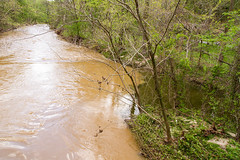People often use parks in urban and suburban areas in a wide variety of ways: hiking, dog walking, running, mountain biking, horseback riding, driving, and playing sports.
In addition, people may misuse the park, by creating unauthorized trails, littering or dumping trash, allowing dogs off leash, not picking up after their dogs, vandalizing park property, or encroaching on its boundaries.
 A spring storm leaves Rock Creek full of muddy stormwater runoff. (Note the clear water of the small tributary feeding in from the right.)
A spring storm leaves Rock Creek full of muddy stormwater runoff. (Note the clear water of the small tributary feeding in from the right.)
Photographer: Sam ShelineStreams in urban and suburban parks are subject to demands as well, because they drain areas covered by construction projects, buildings, streets and parking lots.
All of these demands, and more, can create ecological threats to the natural communities in a park:
- Roads, buildings, and recreational facilities can fragment habitat.
- Animals may be killed on roads in the park.
- People traveling through the park by car, bike, horse, or foot can unintentionally spread weed seeds and/or insect pests and plant diseases on their shoes, clothes, or tires. Pet dogs, especially unleashed dogs, can also spread seeds, pests or diseases on their paws and fur.
- People and their pets can erode hillsides and trample plants when straying from trails.
- Motorized traffic creates air pollution that can harm plants and animals.
- Urban stormwater runoff creates a number of problems, including flooding, erosion, water pollution, and increased turbidity.
- Dams, fords, water diversions, storm sewers, and sanitary sewer lines degrade habitat available to aquatic plants and animals.
- Suppressing fire to protect nearby human property may change the mix of plant species in natural communities that have regularly experienced wildfires in the past.


